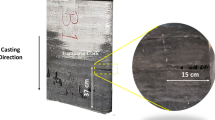Abstract
Nonequilibrium austenite, γ, or duplex austenite + lath martensite,γ+ α′ L, phase wires with high strengths and large elongation have been produced in Fe-Ni-Cr-Al-C alloy system by the in-rotating-water spinning method in which a melt stream is ejected into a rotating water layer. These wires have a circular cross section and a white luster, and the wire diameter is in the range of 80 to 180 µm. The γ phase has a grain size as small as about 1 to 4 µm. The yield strength, Σy, tensile fracture strength, ay, and elongation, εp, are about 340 to 655 MPa, 440 to 975 MPa, and 12 to 22 pct for the γ single phase wires and about 465 to 865 MPa, 640 to 1350 MPa, and 2 to 18 pct for the α′L+γ duplex phase wires. A cold drawing causes significant increases in Σy and Σf, and the attained values are about 3200 MPa and 4030 MPa for Fe-8Ni-12.5Cr-2.5Al-3C wire drawn to about 95 pct reduction in area owing to the formation of a strain-induced α′L phase and a remarkable work-hardening ability of γ and α′L phases. On the subsequent low-temperature annealing around 673 K, the Σy and Σf increase further to 4000 MPa and 4240 MPa, respectively, probably because of the enhancement of the interaction between dislocations and interstitial carbon atoms. Around the temperature (≃800 K) where the γ phase decomposes into a stable mixed structure of α + ordered bec compound + M7C3 on annealing, the εp decreases drastically and the fracture surface morphology changes from a dimple pattern to a cleavage pattern. It has been therefore inferred that the high strengths and good ductility of the melt-quenched y and γ + α′L wires are due to the suppression of the phase transformation of y to a mixed structure of γ + ordered bec compound + M7C3 carbide by the melt-quenching technique.
Similar content being viewed by others
References
T. Minemura, A. Inoue, Y. Kojima, and T. Masumoto:Metall. Trans. A, 1980, vol. 11, p. 671.
T. Minemura, A. Inoue, and T. Masumoto:Trans. Iron, Steel Inst. Japan, 1981, vol. 21, p. 649.
T. Minemura, A. Inoue, Y. Kojima, and T. Masumoto:Trans. Iron, Steel Inst. Japan, 1982, vol. 22, p. 934.
A. Inoue, Y. Kojima, T. Minemura, and T. Masumoto:Metall. Trans. A, 1981, vol. 12, p. 1245.
A. Inoue, H. Tomioka, M. Hagiwara, and T. Masumoto:Trans. Japan Inst. Metals, 1982, vol. 23, p. 341.
A. Inoue, Y. Kojima, T. Minemura, and T. Masumoto:Trans. Iron, Steel Inst. Japan, 1981, vol. 21, p. 656.
A. Inoue, T. Minemura, A. Kitamura, and T. Masumoto:Metall- Trans. A, 1981, vol. 12, p. 1041.
I. Ohnaka, T. Fukusako, and T. Daido:J. Japan Inst. Metals, 1981, vol. 45, p. 751.
T. Masumoto, I. Ohnaka, A. Inoue, and M. Hagiwara:Scripta Met., 1981, vol. 15, p. 293.
I. Ohnaka, T. Fukusako, T. Ohmichi, T. Masumoto, A. Inoue, and M. Hagiwara:Proc. of the 4th Intern. Conf. on Rapidly Quenched Metals, T. Masumoto and K. Suzuki, eds., The Japan Inst. Metals, 1982, vol. I, p. 31.
T. Masumoto, A. Inoue, M. Hagiwara, I. Ohnaka, and T. Fukusako:Proc. of the 4th Intern. Conf. on Rapidly Quenched Metals, T. Masumoto and K. Suzuki, eds., The Japan Inst. Metals, 1982, vol. I, p. 47.
M. Hagiwara, A. Inoue, and T. Masumoto:Metall. Trans. A, 1982, vol. 13, p. 373.
A. Inoue, M. Hagiwara, and T. Masumoto:J. Mater. Sci., 1982, vol. 17, p. 580.
M. Hagiwara, A. Inoue, and T. Masumoto:Mater. Sci. Eng., 1982, vol. 54, p. 197.
A. Inoue, H. Tomioka, and T. Masumoto:Metall. Trans. A, 1983, vol. 14, p. 1367.
B. L. Averbach and M. Cohen:Trans. AIME, 1948, vol. 176, p. 401.
R. L. Miller:Trans. ASM, 1964, vol. 57, p. 892.
JIS Handbook, ed. by the Japan Standard Inst., 1964, p. 534.
S. Floreen and G. W. Tuffnell:Trans. Quart. ASM, 1964, vol. 57, p. 301.
A. Inoue, H. Tomioka, N. Yano, and T. Masumoto: The 5th Intern. Conf. on Rapidly Quenched Metals, Würzburg, Federal Republic of Germany, September 3–7, 1984, to be submitted. $
Author information
Authors and Affiliations
Rights and permissions
About this article
Cite this article
Inoue, A., Tomioka, H. & Masumoto, T. Microstructure and mechanical properties of Fe-Ni-Cr-Al steel wires produced by in-rotating-water spinning method. Metall Trans A 16, 215–226 (1985). https://doi.org/10.1007/BF02816048
Received:
Issue Date:
DOI: https://doi.org/10.1007/BF02816048




